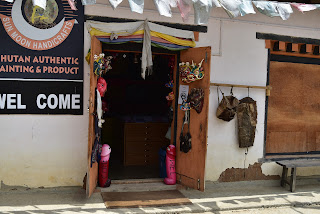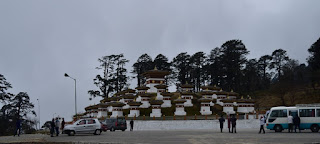Go to part I here
To Bajo city via Punakha
Next day morning, after our breakfast of aloo parathas,
sauce and butter, we started from Thimpu by 8.30 am. After visiting many
beautiful temples on the way, and having lunch at Punakha, we reached Bajo city
by 5 pm.
Punakha had served as the capital of Bhutan until 1955 and, even
today, it is the winter home of the central monk body.
Chimi Lhakhang, (Lhakhang
means monastery or temple in the Bhutanese language)also known as the
“Fertility Temple,” was originally built in 1499 on a short hill that had been
blessed by Buddhist leader Drukpa
Kunley, known as the “Divine Madman.”
Drupa Kunley, also known as “The Saint of 5,000 Women” worked overtime to spread enlightenment through an active sex life. He was known to have had a lifestyle full of wine, women, and poetry. He is also credited with bringing Buddhism to Bhutan, hence the common phallic imagery found throughout the country. The phallus became Drupa Kunley’s symbol,signaling both fertility and the power to bring enlightenment to those who learned from its teachings.
Drupa Kunley, also known as “The Saint of 5,000 Women” worked overtime to spread enlightenment through an active sex life. He was known to have had a lifestyle full of wine, women, and poetry. He is also credited with bringing Buddhism to Bhutan, hence the common phallic imagery found throughout the country. The phallus became Drupa Kunley’s symbol,signaling both fertility and the power to bring enlightenment to those who learned from its teachings.
Thousands of people visit Chimi Lhakhang either to pray for
children by those who are childless or to seek protection for children that
they already have. There are also anecdotes of tourists from the US and Europe
who made the pilgrimage to Chimi Lhakhang and promptly got pregnant within a
year after the visit. We were shown an album with photos of western couples with their kids, got after
the blessings.
Around the time when Drukpa Kuenley first visited Bhutan, a
demoness called Loro Duem resided on a high pass presently called Dochu La. She
terrorised all who tried to cross the pass and the people in the valley lived
in fear. Two more demonesses lived on two smaller passes and the three of them
caused people misery and suffering. When Drukpa Kuenley heard of this, he
hunted down the demoness at Dochu La and the three demonesses recognising
Drukpa Kuenley’s power ran down the valley and the other two demonesses
dissolved into the body of Loro Duem.
When she reached the plains of Lobesa, she transformed
herself into a dog to avoid detection. But Drukpa Kuenley recognised the
demoness dog, killed it and buried it under the mound of a hill. He then said “Chi-med” (no dog), and built a black chorten on top
of this mound. Before killing and burying the demoness, he made the demoness
pledge service to the Buddha and become a protector of the dharma. She is now
the local deity called Chhoekim who is the guardian deity of Chhime Lhakhang.
Drukpa Kuenley’s cousin Lam Ngawang Choegyal later built a
Lhakhang in honour of his illustrious relative and named it Chhime Lhakhang.
I found it very strange that all the dogs (they were not
many) that I saw there were diseased, with open wounds on the body, full of
fleas and always tired and lying down.
The Punakha Dzong (Dzong means fortress) is one of the most historic Dzongs
in the whole country. It is considered to be the 2nd oldest, but most beautiful
of all the Dzongs in Bhutan. Once the Palace of the King of Bhutan, the Dzong
now serves as the Winter Capital for the monastic body of the country. Built by
Shabdrung Ngwang Namgyal in the 17th century, it is located between the
confluence of two rivers: Pho Chhu (male) and Mo Chhu (female).
Punakha Dzong had many huge Buddha idols. There was a small
temple that housed wish fulfilling Buddha adjacent to it, where I had to
witness a sad scene.
Vegetable market- a pathetic scene
In the evening we
walked around in the Bajo town and went into the main vegetable market. The
vegetables were all in bad state. Shrivelled brinjals, mangoes, half dried
ladies fingers , which we won’t even consider cooking, were there for sale.
Towards Paro
Next day morning we started driving towards Paro. We stopped
at Dochula pass on the way. The pass is a
popular location among tourists as it offers a stunning 360 degree panoramic
view of Himalayan mountain range. The view is especially scenic on clear,
winter days with snowcapped mountains forming a majestic backdrop to the
tranquility of the 108 chortens gracing the mountain pass.
Known as the Druk Wangyal Chortens- the construction of these108 chortens was commissioned by the eldest Queen Mother, Her Majesty Ashi Dorji Wangmo Wangchuk. The 108 memorial stupas were built in memory of the 108 Bhutanese soldiers who were killed in the 2003 battle against Indian rebels during the first ever operation “Operation all Clear” conducted by the Royal Bhutan Army.
Known as the Druk Wangyal Chortens- the construction of these108 chortens was commissioned by the eldest Queen Mother, Her Majesty Ashi Dorji Wangmo Wangchuk. The 108 memorial stupas were built in memory of the 108 Bhutanese soldiers who were killed in the 2003 battle against Indian rebels during the first ever operation “Operation all Clear” conducted by the Royal Bhutan Army.
The pass is also popular spiritual
destination for both locals and tourists because an important temple is located
on the crest of Dochula pass.
The Paro Dzong ranks as a high
point of Bhutanese architecture. The massive buttressed walls that tower over
the town are visible throughout the valley. We were told that the idol of
Buddha here was that of 11 year old Siddhartha. So he was having crown and the
eyes were fully opened. But I saw begging bowl in his hand and asked why it was
there. The monk explained that it was to indicate his journey towards
asceticism. He told it is very rare to see the idol of royal Buddha.
Since we started from Paro at 5.30 am on the next day, we were lucky to see it all lit up, a truly divine sight!
Jangtsa Dumgtseg Lhakhang is a notable Buddhist temple as it is in the form of a chorten, very rare in Bhutan. According to a local legend, the Lhakhang was built by the saint Thangtong Gyalpo. It is believed that he built the Lhakhang in this shape to better pin down either a troublesome demoness or a powerful naga spirit. It is a repository of iconography from the Drukpa Kagyu school, with peaceful and wrathful deities dancing on the walls of all three floors, which represent heaven, earth and hell.
It is a very old and powerful temple and of all the temples
visited during this trip, I felt the maximum vibrations here.
Kyichu Lhakhang is another
Buddhist temple in Paro. It is one of the oldest monasteries in the country
built in the 7th century by the Tibetan King Songsten Gampo. The story goes
that a giant demoness lay across the whole area of Tibet and the Himalayas and
was preventing the spread of Buddhism. To overcome her, King Songtsen Gampo
decided to build 108 temples, which would be placed on all the points of her
body. Of these 108 temples, 12 were built by precise plans.
There’s a belief that the two orange trees here in Kyichu
Lakhang bear fruit throughout the year. The trees were totally laden with
fruits when we saw them in March 2017.
The Tiger's Nest Monastery
is probably the most famous in Bhutan,
having been founded in the late 1600's, and perched on a high rocky ledge 900m
above the valley floor allegedly at a place where Guru Rinpoche rested,
travelling on a flying tiger.
From the parking area it is a two to three hour walk, mostly
through coniferous forest, up a steep path to the view point from where there
are spectacular views of the monastery.
Time to leave
After a nice rest at the hotel, we started from Paro and reached
Jaigaon by 10.30am. The moment we crossed the Bhutanese gate and entered India,
I was hit by the mental noise.
It was so conspicuous. Six days in that country
gave an unparalleled mental calmness. Internet usage in Bhutan is not widespread
like in India may be a reason, but the people there are more grounded and
satisfied with their lives.
Kudos to the King
I think the Bhutanese king has the well being of his
subjects in mind. He encourages local cultivation; even he eats the local red
rice. The whole population wears the national dress, including the school children.
National television broadcasts in English language, so the people talk good
English, there was no difficulty in communication. From what we observed in six
days, the interaction between the genders was very normal and neutral. It
looked like, to us, that eve teasing may not be a problem there.
Wangchuks - The Great Wangchuk Dynasty is the real reason for Bhutan being such a special country.
When asked about Bhutan’s “uniqueness” or “specialty”, people often come up with lists which includes one or all of the following points:
Only carbon sink in the world.
Has highest unclimbed mountain in the world.
Has 72% forest cover.
Happiest country of the world.
Total tobacco ban.
No traffic lights in entire country.
Gave concept of Gross National Happiness (GNH) to the world.
Wangchuks - The Great Wangchuk Dynasty is the real reason for Bhutan being such a special country.
When asked about Bhutan’s “uniqueness” or “specialty”, people often come up with lists which includes one or all of the following points:
Only carbon sink in the world.
Has highest unclimbed mountain in the world.
Has 72% forest cover.
Happiest country of the world.
Total tobacco ban.
No traffic lights in entire country.
Gave concept of Gross National Happiness (GNH) to the world.



















No comments:
Post a Comment